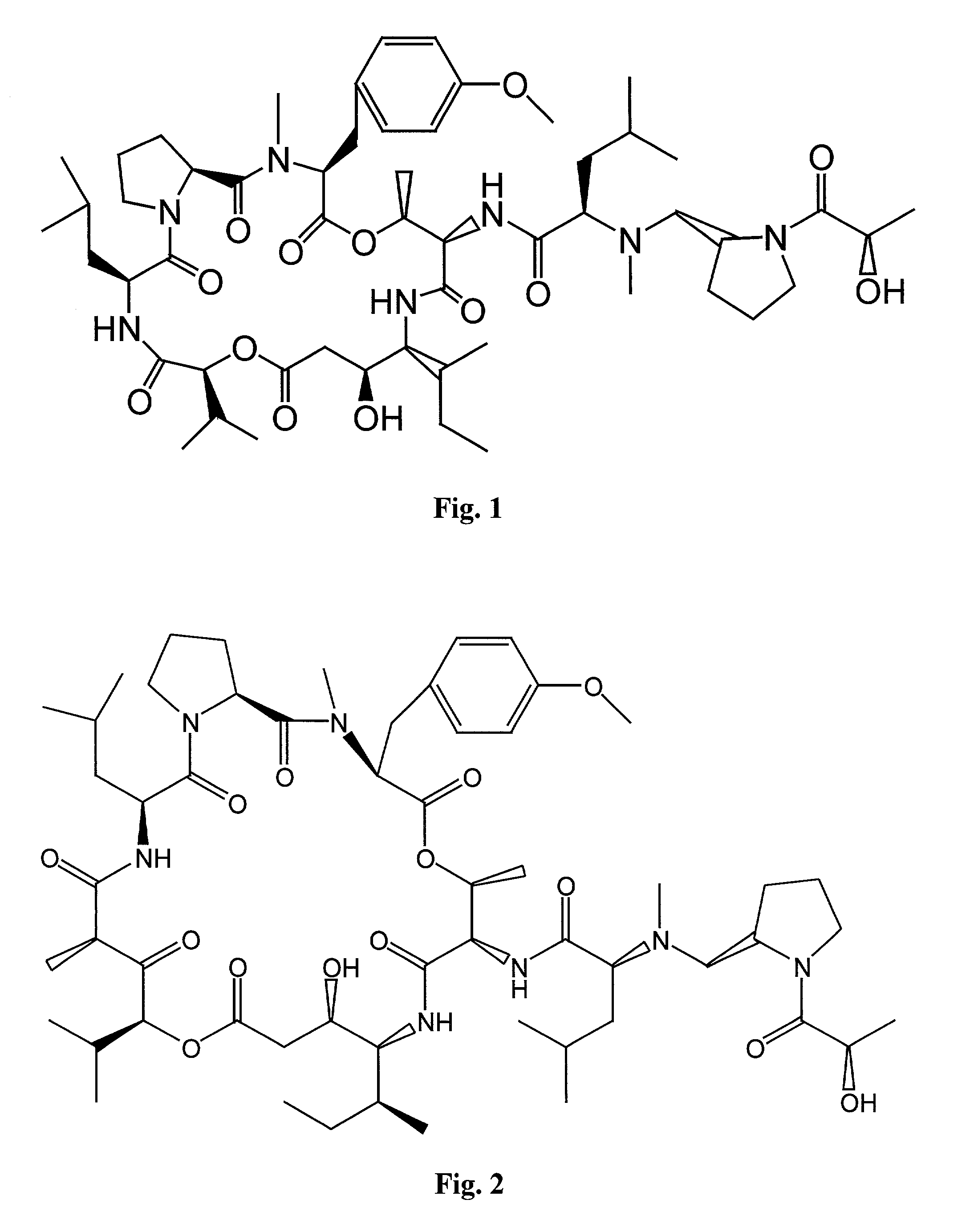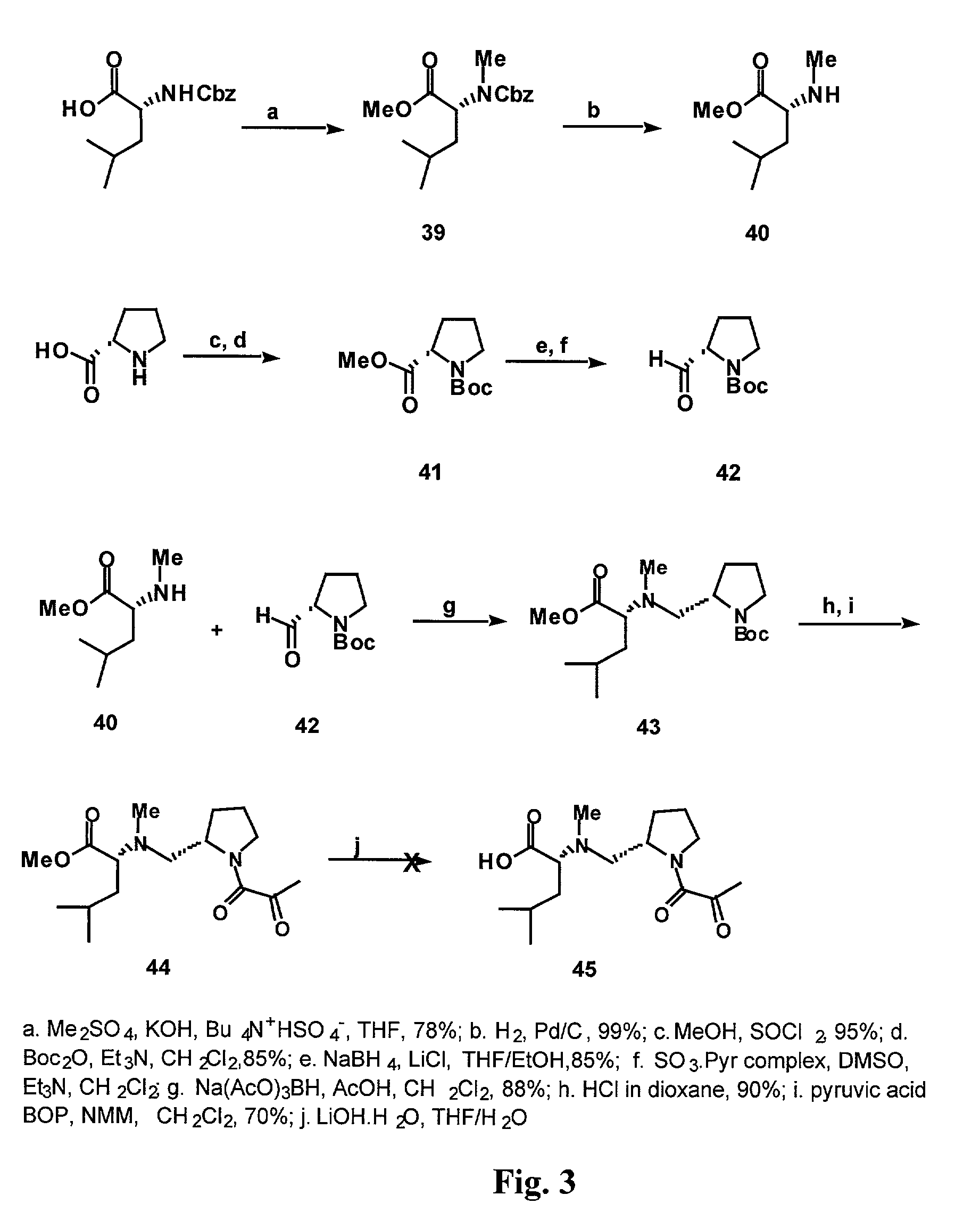Deoxo-proline-containing tamandarin and didemnin analogs, dehydro-proline-containing tamandarin and didemnin analogs, and methods of making and using them
a technology of tamandarin and didemnin, which is applied in the field of dehydroproline-containing tamandarin and didemnin analogs, can solve the problems of limited supply of tamandarin a that is available, difficulty and expense of isolating this product, and hampered clinical effectiveness, so as to inhibit growth, inhibit protein synthesis and proliferation
- Summary
- Abstract
- Description
- Claims
- Application Information
AI Technical Summary
Benefits of technology
Problems solved by technology
Method used
Image
Examples
example 1
Synthesis of a Deoxo-Proline Side Chain Moiety and Coupling to a Didemnin Macrocycle
[0174]An amino methylene single bond was used to replace the amide bond between D-leucine and L-proline in the side chain of didemnin B. Synthetically, the amino methylene bond was prepared by reductive amination, as described (Abdel-Magid et al., 1990, Tetrahedron Lett. 31:5595–5598; Abdel-Magid et al., 1990, Synlett. 537–539).
[0175]In a first synthetic method, exhaustive methylation of Cbz-D-leucine was performed using dimethylsulfate, as illustrated in FIG. 3. The Cbz group was removed using hydrogenolysis to yield dimethylated D-leucine free amine (Compound 40). The amine was used in reductive amination without purification. Commercially available L-proline was first esterified using SOCl2 in MeOH, and its amino group was subsequently protected using Boc2O. After purification, the ester function was reduced to an aldehyde in two steps. NaBH4 was combined with LiCl to generate LiBH4 in situ, and t...
example 2
Synthesis of a 3,4-Dehydro-Proline Side Chain Moiety and Coupling to a Didemnin Macrocycle
[0212]Synthesis of the 3,4-dehydroproline unit began with trans-4-hydroxy-L-proline (compound 52), which was produced as described (Rueger et al., 1982, Can. J. Chem. 60:2918; see FIG. 6). The acid was first protected as its ethyl ester. The amino group was further protected using Boc2O to yield compound 53. The hydroxyl group was mesylated using MsCl and pyridine. The mesylate (i.e., methyl sulfonate moiety of compound 53) was displaced by sodium benzene selenide with inversion of stereochemistry to yield compound 54. Oxidative elimination of the phenyl selenium group afforded the corresponding alkene (compound 55) in 73% yield.
[0213]If compound 54 was directly exposed to the basic elimination condition, two regioisomers would be generated. But oxidative elimination of compound 54 through phenyl selenium as the intermediate gave only the desired regioisomer. This regioselectivity may be due to...
PUM
| Property | Measurement | Unit |
|---|---|---|
| Structure | aaaaa | aaaaa |
| Pharmaceutically acceptable | aaaaa | aaaaa |
Abstract
Description
Claims
Application Information
 Login to View More
Login to View More - R&D
- Intellectual Property
- Life Sciences
- Materials
- Tech Scout
- Unparalleled Data Quality
- Higher Quality Content
- 60% Fewer Hallucinations
Browse by: Latest US Patents, China's latest patents, Technical Efficacy Thesaurus, Application Domain, Technology Topic, Popular Technical Reports.
© 2025 PatSnap. All rights reserved.Legal|Privacy policy|Modern Slavery Act Transparency Statement|Sitemap|About US| Contact US: help@patsnap.com



